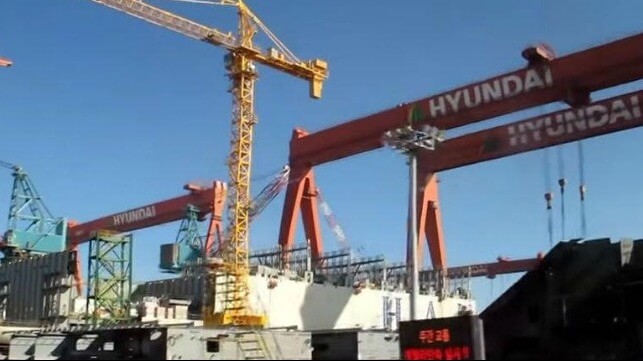Report: KSOE Designed Nuclear Powered Hydrogen Production Barge

Korea Shipbuilding & Offshore Engineering (KSOE) is continued to pursue its interest in nuclear power. Seen as a technology that could provide a means of addressing the need for power in remote areas and reducing carbon emissions, efforts are underway to develop small modular nuclear reactors for a variety of applications including power barges. KSOE is looking to use the power source as part of a floating production unit for alternative fuel.
The parent of South Korea’s largest shipbuilder revealed it has developed a barge concept similar to the concept used in offshore energy during a presentation last Friday, March 10, in South Korea according to a report in today’s issue of BusinessKorea. KOSE is reported to be promoting the basic design for a production barge power multiple modular reactions with a maximum capacity of up to 240 MW.
In its first design, KSOE proposes using four sets of 60 MW small modular reactors according to the report. The reactors would be placed in a floating facility and used to power carbon-free fuel production such as hydrogen. Other have also looked at the idea of floating hydrogen production but they are linking their concepts to power from wind farms or other sources.
KSOE reportedly views the use of the reactions as a means to produce hydrogen at a low cost. The shipbuilder has previously said it would be exploring a variety of different applications for nuclear power. They joined with other investors in funding a nuclear power company, TerraPower, founded by Bill Gates providing $30 million of a total $830 in private equity financing last fall.
“KSOE has been following the development status of SMR technologies for its various applications and decarbonization ability for quite a long time KSOE,” the company’s vice chairman and chief executive Sam H Ka said when announcing the investment in TerraPower. “We are glad to invest in TerraPower and contribute to the global net-zero transition. KSOE, with other affiliates of HHI Group, will continuously seek opportunities that could decarbonize our industry and also support the global net-zero transition.”
Separately, nine Korean organizations announced a similar effort last month to work together in the development and demonstration of offshore systems powered as well as ships with small modular reactors. The partners said they would be working on a range of technologies including seeking to develop marine systems and the production of hydrogen using molten salt reactors (MSRs).
Other, including Samsung Heavy Industries with Seaborg Technologies and Washington state-based ThorCon with the Indonesia’s power and research innovation authorities are both working on designs to use small reactors to generate power. In their floating designs, the power barges would be used to connect to existing power grid to expand the power generation capacity.
The U.S. Department of Energy has said that Advanced Small Modular Reactors (SMRs) are a key part of the Department’s goal to develop safe, clean, and affordable nuclear power options. They explained that the advanced SMRs currently under development in the United States represent a variety of sizes, technology options, capabilities, and deployment scenarios. They are exploring the use of these systems for power generation, process heat, desalination, or other industrial uses. SMR designs they noted may employ light water as a coolant or other non-light water coolants such as gas, liquid metal, or molten salt.
The International Atomic Energy Agency categorizes SMRs as having between 10 and 300 MW capacity and highlights that the prefabricated nature and smaller size make them suited for these types of applications. In comparison to existing reactors, the IAEA says proposed SMR designs are generally simpler, and the safety concept for SMRs often relies more on passive systems and inherent safety characteristics of the reactor, such as low power and operating pressure.
The world’s first floating nuclear power plant that began commercial operation in May 2020 in Russia, producing energy from two 35 MW(e) SMRs reports the IAEA. They calculate that more than 70 commercial SMR designs are being developed around the world including in Argentina, Canada, China, Russia, South Korea, and the United States of America.
